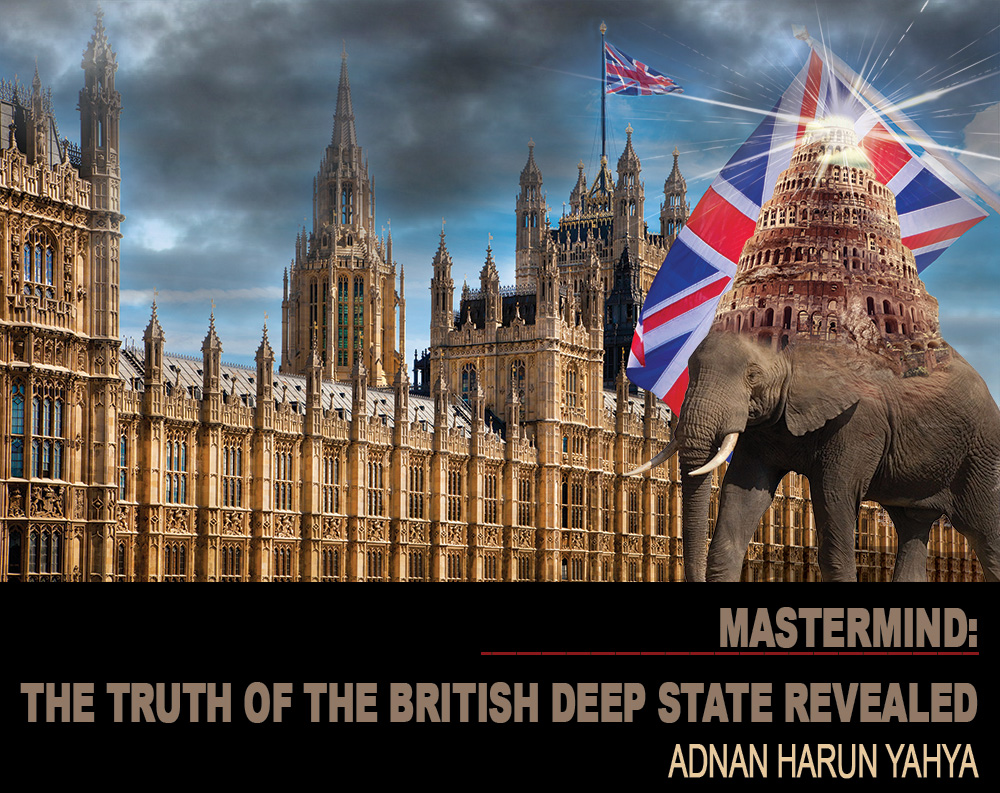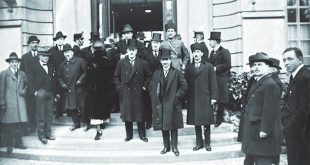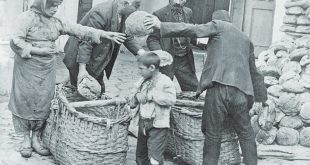When Sir Adam Block, the British delegate and President of the Council of the Ottoman Public Debt Administration, was preparing to leave Istanbul after war was declared in 1914, he made the following strange remark:
If Germany wins, you will be a German colony. But if Britain wins, you will perish! 334
 |
The devastating WWI that started with the firing of a pistol on July 28, 1914 came to an official end on November 11, 1918. Around two months after the finalization of hostilities, the Paris Peace Conference was convened. On January 18, 1919 some of the parties began to enforce the secret deals they had previously drafted while the war was still raging on. Britain and France, to avoid complete violation of Wilson’s Fourteen Points, but not willing to give up on their colonial aspirations, proposed ‘war reparations’ instead of ‘war indemnity’ and ‘mandates’ instead of ‘colonialism’.
The Paris Peace Conference witnessed heated discussions on the laws of war and on the sharing of territory; but these weren’t the only topics debated. Secret steps were being taken to shape a new world order. With a session held on May 30, 1919, it was decided to make an elusive organization official, which the world’s deep state would later use to shape the world. To better understand this structure, which is today known as the ‘Chatham House’, let’s first learn some facts about its founding father, Lionel George Curtis.
Architects of the Treaty of Sèvres
Lionel Curtis first came to prominence during his activities in the British colonies in South Africa between 1899-1909. Appointed by Sir Alfred Milner to carry out various duties in the region, Curtis was accompanied by other Oxford graduates, who were also sent by Milner.
Known as ‘Milner’s Kindergarten’, this was a close-knit group of people with similar educational backgrounds, lifestyles and shared values. They spent their time together in South Africa, and had frequent debates on social and political matters. The Kindergarten consisted of the following people:
- George Geoffrey Dawson: Director and Editor of the Times magazine
- Richard Feetham: Lawyer, Judge of Appeal on the South Africa Court of Appeals, member of the Transvaal Legislative Council
- William Lionel Hitchens: Chairman of the English Electric Company
- Robert Henry Brand: Managing director in Lazard Brothers Co.
- Sir Patrick Duncan: Governor General of South Africa
- John Dove: Journalist, editor of the Round Table journal
- J. F. (Peter) Perry
- Geoffrey Robinson
- Hugh Wyndham
 |
| (1) The final march of British soldiers in South Africa, following the Anglo-Boer War, started by the British deep state. (2) British soldiers in South Africa |
After 1905, Philip Kerr (British ambassador to the US, 1939-1940), Lord Selborne and Sir Dougal Orme Malcolm also became a part of the group.
The activities of the Kindergarten group continued long after these particular members left South Africa.
The goal of Alfred Milner was uniting the South African colonies under the British flag. He helped transfer money to the Kindergarten from the ‘Rhodes Scholarship’, which was previously set up in line with Cecil Rhodes’ will. The readers will recall from the first chapters of the book that Cecil Rhodes was one of the prominent Darwinist and racist members of the British deep state, who became rich in South Africa through diamond trade and mining.
In the meantime, Lionel Curtis began to be called ‘the prophet’ within the Kindergarten (Certainly prophets are above such remarks). Curtis managed to unite South Africa on May 31, 1910, through his pursuit of a global ideal. To Curtis, South Africa was a ‘microcosm’ and what was true for the British Empire was equally true in South Africa. After the unification was completed on the continent, he believed that the Kindergarten could “begin some work of the same kind” on the scale of the Empire.335
 |
| (1) The British deep state enrolled selected African youngsters into European universities, who would later go on to represent the deep state’s interests in Africa. (2) The British deep state brought Indian workers to South Africa. These people were identified only by the numbers they were carrying on them. |
In 1909, Alfred Milner met with potential sponsors and supporters helping Lionel Curtis with one more task: enabling him to organize a Round Table meeting in the residence of Lord Anglesey at Plas Newydd in Wales, Great Britain on September 4-5, 1909. In addition to the Kindergarten team, Lords Howick, Lovat, Wolmer and F. S. Oliver were also in attendance. Shortly after, another exclusively British lineup joined, which included Leo Amery, Lord Robert Cecil, Reginald Coupland, Edward Grigg and Alfred Zimmern.
Lionel Curtis published an article in December 1918 in the Round Table publication, where he proposed that a League of Nations should be built after WWI to oversee a worldwide mandatory system. He believed that a British-American alliance in the management of the system would ensure international balance. Consequently, he was invited to the Paris Peace Conference. Then, he attended the League of Nations session chaired by Robert Cecil from the British Ministry of Information, who was also in the cadres of the Round Table. In 1919, the American-British Institute of International Affairs was founded, which would later transform into CFR (the Council on Foreign Relations) in New York, and the Royal Institute of International Affairs, a.k.a. Chatham House, in London.
 |
| Zulu workers were forced to work as slaves at De Beers diamond mines, Kimberley, South Africa. In 1887- 1888, racist British diplomat Cecil Rhodes, amalgamated the diamond mines which included De Beers, into Consolidated Mines based in the UK. |
First presidents of Chatham House:
- Lord Robert Cecil
- Arthur James Balfour
- John R. Clynes
- Viscount Edward Grey
Interestingly, this lineup was also behind the dismemberment plans made for the Ottoman Empire in the Paris Peace Conference as well as the Treaty of Sèvres.
Furthermore, again during the conference, the British-led commission decided to build the League of Nations.
New Turkey on the way to Lausanne
The defeat of the Greek army in Anatolia on August 30, 1922 by the Turkish army led to the Armistice of Mudanya on October 11, 1922. This cease-fire agreement stipulated that occupation forces leave Turkish territory and a final peace treaty be signed. Accordingly, the Allies sent a notice on October 27, 1922 to the Ankara government and invited it to the peace conference that would start in Lausanne on November 13, 1922.
Turkey fought 10 years to be able to reach the road to Lausanne. From the Balkan Wars that started in 1912 until the end of the Turkish Independence War in 1922, 5 million people lost their lives. Compared to other countries that fought in WWI, this represented the biggest casualty. The Turkish nation emerged battered, tired and impoverished from this horrible war and it lacked a state. However, despite all the setbacks, the Turkish people never gave up and made a comeback with a new state through the Treaty of Lausanne. This treaty is the sole peace treaty that is still in effect since WWI. All other treaties signed in the post-war era were revoked by WWII. In other words, Turkey is the only country that has spent the last 93 years without a war.
 |
| The building where the Armistice of Mudanya was signed in 1922. |
 |
| (1) General Harington (2) İsmet Pasha in front of the same building |
The Conference of Lausanne was an arduous, tense and strenuous negotiation process that saw hard bargaining. The negotiations started on November 20, 1922 but only on July 24, 1923 were the parties able to reach an agreement and sign the treaty. Furthermore, matters like Mosul, the Straits and Hatay could not be solved and were postponed to a later date. From time to time, talks hit a dead end and were halted or suspended. However, the new Turkish state was resolute on the National Pact (Misak-ı Milli) and would not budge on its stance on the Straits or the capitulations. Therefore, when the negotiations came to an end, the National Pact borders were preserved to a large extent despite minor surrender of some lands.
Britain, which proved to be the main source of difficulty for the new Turkish state during the negotiation process, due to its deceitful policies and ruses – even intercepting telegrams of the Turkish delegation – intensely employed deep state policies during the Lausanne negotiations and did its best to try and ambush the Turkish side.
Britain before the Lausanne negotiations
It will be helpful to understand the British approach to Turkey before the Lausanne negotiations, and how it shaped its relevant strategies under the influence of the deep state. This point is important because this section of the book will focus mainly on the British deep state ruses against Turkey during the negotiations. To do that, one should first understand how the then British leaders viewed Turks and young Turkey.
Most British leaders, as previously explained, are selected among people that will risk almost everything for the ‘interests of Britain’ and the selection is almost always made by the British deep state. Because of this strategy, all the Conservative leaders that took office throughout history saw Russia as a big threat and opted to support the Ottoman against this threat. Needless to say, Ottoman being a powerful empire played a huge role in that policy. However, it should be well remembered that the British deep state inherently chooses to side with the might and not the right.
When the Ottoman Empire began to lose its power, and became vulnerable as ‘a rich source ready to be exploited’, the policies of the British deep state changed. This shift in attitude was marked by the Liberal Party’s Gladstone assuming power in 1880 and his sudden hostile attitude towards the Ottoman Empire. Gladstone’s East policy, as explained before, was largely built on hatred that reveals itself in the following baseless claims (Noble Turkish nation is above such claims):
No government ever has so sinned, none has proved itself so incorrigible in sin, or which is the same, so impotent in reformation.336
Let the Turks now carry away their abuses, in the only possible manner, namely, by carrying off themselves.337
Surely, it is not a coincidence that these remarks were uttered at a time when the British deep state started propagating the lie of Darwinism and when Darwin particularly singled out the Turks as a ‘primitive race’ (Noble Turkish nation is above such remarks). Superior-inferior race concepts, developed by means of the false theory of evolution, are nothing but a deceit and a curse introduced to the world by, again, the British deep state. The policy of hostility towards Turks was developed in line with that strategy.
 |
|
| 1. Picture taken in Izmir, the day after the Treaty of Sévres was signed | 2. William Ewart Gladstone |
 |
| Damat Ferid and Sèvres delegation |
The anti-Turkish policy of Lloyd George, who was another Liberal Party Prime Minister of Britain during the Lausanne negotiations, should be studied as a phenomenon not separate from the said strategy. The following 1914 remarks of Lloyd George clearly show his ill-natured outlook on the Turks:
The Turks are a human cancer, a creeping agony in the flesh of the lands which they misgovern, rotting every fibre of life. And now that the great day of reckoning has come upon the nation, I am glad. I am glad the Turk is to be called to a final account for his long record of infamy against humanity in this gigantic battle between right and wrong.338
At the end of the war, Lloyd George was boasting about having defeated the Ottoman Empire, supposedly the best thing Britain had ever done. However, he was unwittingly revealing the 500-year-old insidious plan of the British deep state. He wanted to take control of Anatolia, deprive the Turks of land to live on and even wanted to completely annihilate them. No one was able to do that before. George, being among the victors of WWI, must have believed that he finally had done it. His words during a speech given at the House of Commons on October 29, 1919, suggest so:
Practically the whole of the conquest of Turkey was the achievement of British arms. There were 1,500,000 men put into the fight with Turkey. It was the achievement of Great Britain, and we have got to hold it now. That is our doing. We have accomplished one of the finest tasks for civilisation this country has ever set its hand to—the emancipation of a vast country, one of the richest in the world, from the blighting influence of the Turk. After civilisation has failed for hundreds of years to accomplish it, Britain has done it.339
The Treaty of Sévres was so destructive for the Turks, it could well have been the dream of Lloyd George. The British deep state didn’t come up with such a destructive treaty even for Germany, which started the war in the first place. Even though all the defeated countries had to surrender some territory, the treaties signed with them didn’t make their entire countries open to occupation, like Turkey did. Lloyd George was convinced during the war that the ones that really needed to be ‘punished’ were the Turks. He believed that the goal of the ‘Question of the East’, a project of centuries, had to be achieved. The British deep state was never comfortable with the Turks continuing their presence strongly in the middle of that ‘question’. It must have seen the outcome of WWI as an opportunity for a true solution to this ‘problem’, because Lloyd George didn’t hesitate from voicing his intentions after the war (Noble Turkish nation is above such remarks):
When peace conditions [of Sévres] are announced the Turks will see what heavy punishment will be meted out to them for their madness, their blindness and their crimes… The punishment will be such it will satisfy even their greatest enemies.340
 |
|
| 1. Venizelos signing the Treaty of Sévres | 2. A caricature depicting the situation of the defeated countries after they signed treaties at the end of WWI |
Sévres was indeed the death warrant of the Ottoman Empire, drawn up with this hatred, and it was built on the centuries-old plans of the British deep state. The Istanbul Government, affected by defeat, signed this death warrant without hesitation, and the Allied Powers, acting under the directions of the British deep state, one by one, began to invade our beautiful country.
It should be remembered that the destiny created by our Almighty Lord will always be in favor of the good and the innocent. Once again, this is what happened with Turkey. Even though Turkey lost in WWI, it didn’t really lose. Lloyd George, the Turkophobe, made a big mistake. He underestimated Mustafa Kemal, his comrades, and the brave and pious Turkish people. The victors will always be the supporters of God.
As for those who make God their friend, and His Messenger and those who have faith: it is the party of God who are victorious! (Qur’an, 5:56)
The Turkish militia force led by Mustafa Kemal put up a great fight and pushed back the arrogant invasions of the Allies to rewrite the history of bravery. Lloyd George’s plans failed one after another as the Turkish state and nation weren’t made history, and didn’t leave Europe. The so-called Sévres ‘punishment’, in the words of George, was thrown away unrealized. The British deep state was heavily routed by the new Turkish state and was forced to sit down at the table at Lausanne, following an epic Turkish victory.
The Lausanne negotiations have been analyzed and studied so many times before. However, this book focuses on the sensitivities of the British deep state, which came to light during the negotiations: Mosul and capitulations. Understanding these points is crucial because the unyielding attitude of the British regarding these topics during the talks gave away its future plans for the Middle East and Turkey. Indeed, they were the reason why the Lausanne negotiations came to a halt and even at one point, the resumption of the war preparations. Today, we can better understand the large-scale plans behind these two points, which the British side so adamantly pushed during those days.
To better understand this plan, first let’s look at the root causes of the scourge of the PKK and the so-called ‘Kurdish issue’ that certain parties try to show as a problem for Turkey. The Mosul talks at Lausanne reveal a lot about it.
Footnotes:
334. Falih Rıfkı Atay, Çankaya, Doğan Kardeş Publishing, Istanbul, 1969, p. 127
335. Andrea Bosco, The Round Table Movement and the Fall of the ‘Second’ British Empire (1909-1919), Cambridge Scholars Publishing, UK, 2017, p. 160
336. John Murray, Bulgarian Horrors and the Question of the East, Albemarle Street, p. 31
337. Michael Partridge, Gladstone, Routledge, New York, 2003, p. 158
338. From a speech by British Prime Minister David Lloyd George, 1914: H. W. V. Temperley, ed., A History of the Peace Conference of Paris, Oxford 1969, VI, 24; Silent Capitulations: The Kemalist Republic Under Assault, p. 119
339. Parliamentary Debates (Commons), Vol. CXX (October 30, 1919), pp. 977, http://hansard.millbanksystems.com/commons/1919/oct/30/finance
340. Alex J. Bellamy, Massacres & Morality, Mass Atrocities in an Age of Civilian Immunity, p. 67
 British Deep State MASTERMIND: THE TRUTH OF THE BRITISH DEEP STATE REVEALED
British Deep State MASTERMIND: THE TRUTH OF THE BRITISH DEEP STATE REVEALED

